Atelier Bonryu(E)
zone plate photography


Atelier Bonryu(E)
zone plate photography







Laboratory: Zone Plate Photography
Taking Zone Plate Photographs
- Macro-Photography by a Zone Plate (2)-
Features of Zone Plate Macro-Photography: As described in the previous page, a zone plate macro-photograph can be taken by adjusting distances to an object and an image plane so that the formula of image formation is satisfied. It may be safe to say that the features of a zone plate have been studied sufficiently and it is applied to many tasks in fields of science and technology as the X-ray photography, the control of a particle beam, astronomy and so on. However, the features of a zone plate have not been understood well in the field of the artistic photography. Therefore, we would like to reconsider here the features of the zone plate photography more comprehensively.
At first, the resolution of an image projected by a zone plate is very good which is clearer than that of an image projected by a pinhole. In the second place, a sharper zone plate photograph can be taken by focusing a camera according to the formula of image formation because a focal length of a zone plate is defined unlike a pinhole camera (there is neither focus nor focal length in a pinhole camera). However, these features are not well caught for taking an artistic photograph. Instead, it seems that the features of the zone plate photograph are understood inversely. For example, it is believed that a zone plate photograph is very soft and it is by far blurred in comparison with a pinhole photograph. And it is also considered that a zone plate camera is always of infinitely deep focus like a pinhole camera, which may be the direct consequence of the fact that in most cases a zone plate photograph is taken by using a zone plate attached to a hole bored in the center of a body cap of a camera. As for the former we described several times the reason why an original zone plate photograph looks blurred and how to make clear the blurred zone plate photograph. Concerning the latter problem a rather clear macro-photograph can be taken by adjusting the distances to an object and to an image plane from a zone plate despite the fact that it is a lensless camera. As it relates with the depth of field, we consider in the following the depth of field of a zone plate camera in connection with the zone plate macro-photography.
Depth of Field (DoF) of Zone Plate `Photography: Depth of Field (DoF) is a range of the distance to an object where an acceptably sharp photograph can be taken. When this range is wide, it is said that the depth of field is deep and in the opposite case the depth of field is shallow. In order to define the depth of field quantitatively, a concept of a “confusion circle” is introduced and the DoF is defined as “the range of distance where the diameter of the confusion circle is less than the acceptable diameter of a confusion circle”. Even when an object is a perfect point light source the image of the object will be a finite area because of various kinds of aberrations and lack of focusing. We consider the area as a circle and name it a “confusion circle”. As the photograph looks blurred when the diameter of the confusion circle is large, we consider that the photograph is in focus when the diameter of the confusion circle is less than the diameter of the “acceptable confusion circle”. Though there is not a common value of the diameter of the acceptable confusion circle defined, usually about 1/1500 of the diagonal of a frame of a film or a sensor area of a digital camera is employed as the diameter of a acceptable confusion circle. Though in the case of the zone plate reason why the confusion circle exists is different from the case of a lens, relation between the depth of field and the confusion circle can be discussed similarly. With the zone plate macro-photography in mind we investigate diffractive behavior of the zone plate here.
Analysis of Diffraction by a Zone Plate: We analyze the diffraction by a zone plate with a focal length of 50 mm and the zone number of 19 designed for a light with a wavelength of 550 nm. Figure 1 shows the light intensity on the image plane versus the position of the light source for various locations of the image plane. At a position where the value of vertical axis is positive the image is in focus. Therefore, the depth of field is expressed as the region where the value of the curve is positive. For example,
in the case of the black solid line which represents the case where the digital sensor is located at the point of 50 mm (the focal length ) from the zone plate, the curve is positive at 500 mm and farther from the zone plate. This means that the camera is in focus as long as the point light source is located within the range from 500 mm to infinity. When we take a zone plate photograph, it is usually the case that a zone plate with a focal length of a flange back of a camera is pasted to the center of a bored body cap and the case of the curve with black solid line corresponds to this deep depth of field case.
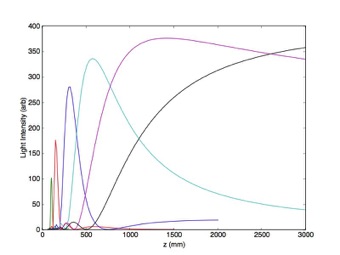
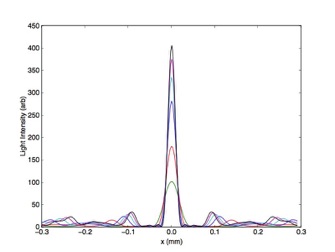
Close-Up Photography by a Zone Plate: Figure 1 shows the light intensity on the image plane located at 100 mm (green), 75 mm (red), 60 mm (blue), 55 mm (cyan), 52 mm (magenta), and 50 mm (black). As described previously if the image plane is located at 50 - 52 mm it is very deep focus but if the image plane is moved farther from the zone plate the depth of field suddenly becomes shallow. When the image plane is located at twice the focal length, that is, 100 mm in this case, the depth of field becomes as short as 85 - 125 mm. This means that a photograph of the object cannot be taken unless the object location is determined within the accuracy of about 20 mm. In this condition as the distance to the image plane is about the same as the distance to the object we take a macro-photograph with the magnification of unity. In this way the depth of field becomes short with reducing the distance to the object as in the case of a camera with a lens. However, as admitting that the “lens speed” of a zone plate is far faster than that of a pinhole it is still slower than a lens and it is rather hard to make the object in focus by looking at an image in a view finder or a live view screen.
Figure 1: Relation between the position of the image plane and the depth of field
Light intensity of an image of a point light source by a zone plate with a focal length of 50 mm and zone number of 19 designed for the light with wavelength of 550 nm is shown for the positions of the image plane at 100 mm (green), 75 mm (red), 60 mm (blue), 55 mm (cyan), 52 mm (magenta), and 50 mm (black).
Figure 2: Images of the point light source for different positions of the image plane
Horizontal dependences of light intensity on the image plane are shown. Correspondence of the color and the image plane position is the same as Fig.1.
Summary of the Features of the Zone Plate Macro-Photography: We summarize what we described up to now and some important features of the zone plate macro-photography which have not been mentioned.
(1)In a zone plate camera the focus adjustment is possible as in the case of a camera with a lens.
(2)By making the distance to the image plane long and the distance to the object short we can take a zone plate macro-photograph. However, as shown in the graph of Fig.2 with decreasing the distance to the object the resolution is deteriorated a little and the light intensity at the image plane decreases. As the rectilinear light emitted from a point source at a finite distance from the zone plate widens conically outwards unlike the light from the point light source at infinity, the density of the background light decreases and the halo becomes less predominant.
(3)The above remarks are for a light with a single wavelength. However, we should remember that the light by which we take a photograph is composed of lights with various wavelengths. For a light with a different wavelength the same zone plate behaves as a different zone plate with a different wavelength. For example, a zone plate with a focal length of 50 mm for the light with the wavelength of 550 nm behaves as a zone plate with a focal length of (50 x 550)/600 = 45.8 mm for the light with the wavelength of 600 nm. For this reason sometimes objects in a wide range of distance are rather easily in focus even when it is in a shallow depth of field. As a matter of course the focus adjustment is very important for the macro-photography.
(4)In a zone plate photograph in the condition of shallow depth of field objects out of focus are not seen on the image plane. Meanwhile in a photograph by a camera with a lens objects out of focus are seen but blurred. This is because in the zone plate photograph the diffractive images are not produced outside of the depth of focus. Therefore, by using the zone plate a bright image of object with halo often emerges in a dark background (Fig.3).
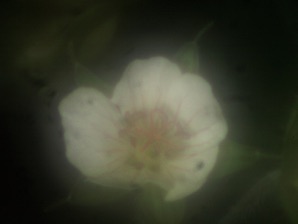

Figure 3: A zone plate macro-photograph and a photograph by a camera with a lens (Geranium thunbergii)
The left photograph is a zone plate macro-photograph of Geranium thunbergii taken by a Fresnel zone plate with a focal length of 100 mm and a zone number of 39 loaded to the Olympus E-510 camera. As the sensor of the Olympus SLR is four-thirds format(17 mm x 13 mm) and the diameter of the flower of Geranium thunbergii is 7~8 mm it is known that the photograph is a macro-photograph with a magnification of unity. The right picture is the same flower taken by a camera with a lens.



High Resolution of a Zone Plate Photograph: From the descriptions up to now it may be understandable that the resolution of a zone plate photograph is very high in comparison with a usual pinhole photograph. Here we prove the high resolution of the zone plate photograph by showing a photograph of a small object which is very difficult to see by naked eyes. The object is a thin line with a width of about 0.2 mm printed on a back side of a Japanese bill of JPY 10000 (Fig.4). This line is composed of an alphabetical character string “....NIPPONGINKO....” (Fig.5, by Supermacro mode of Olympus TG-2). We have taken zone plate macro-photographs by using a zone plate with a focal length f=50 mm and zone number N=19. Figure 6 and 7 are the photographs of the magnifications m=1.2 (a=91 mm, b=111 mm) and m=2.1 (a=94 mm, b=156 mm), respectively. Though they are not very clear, we can read the very small sized character string in the photographs with both the magnifications.

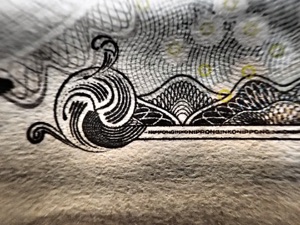
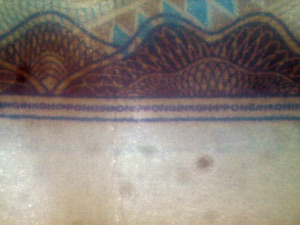
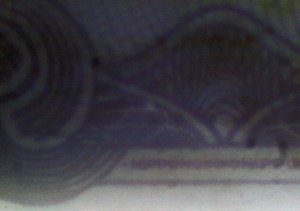
Fig.4: The hided alphabetical character string in the back side of a Japanese bill of JPY10000
Taken by Olympus TG-2
Fig.5: The hided alphabetical character string in the back side of a Japanese bill of JPY10000
Supermacro mode of TOlympus TG-2
Fig.6: Zone plate macro-photograph of the micro-character string in the back side of a bill
A Fresnel zone plate with focal length of 50 mm and zone number of N=29, attached to an Olympus E-510 camera. Distance to the object a=91 mm, distance to an image b=111 mm and the magnification m=1.2.
Fig.7: Zone plate macro-photograph of the micro-character string in the back side of a bill
A Fresnel zone plate with focal length of 50 mm and zone number of N=29, attached to an Olympus E-510 camera. Distance to the object a=94 mm, distance to an image b=156 mm and the magnification m=2.1.

